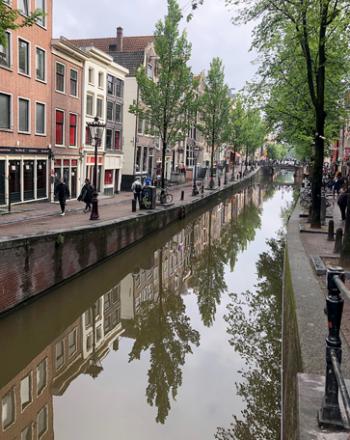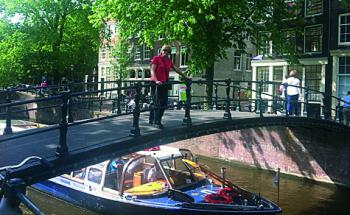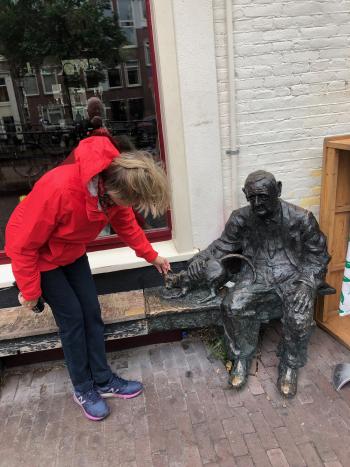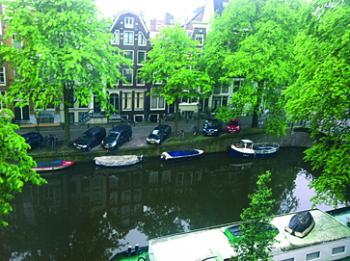Advice on visiting Amsterdam
This item appears on page 16 of the December 2019 issue.
My wife, Thea, and I have visited Amsterdam in the Netherlands several times over the last few years, most recently in June 2019. We often get asked by friends and family for advice about visiting there, so I came up with the following notes.
Amsterdam is a great city for just “chilling” — wandering around the centre, enjoying a coffee or beer, watching people, window-shopping, etc.
Beware of bicycles. Cyclists will ring their bells and expect you to jump; you have to be nimble! What I found confusing was that roads have both cycle tracks and pedestrian pavements next to them. Sometimes I thought I was on pedestrian paving when it was, in fact, a cycle track.
The city’s public transport is super-efficient, especially the trams. (If you have ambulatory problems, find a hotel close to a tram stop, perhaps with an entrance opposite the stop.)
You could book a self-catering B&B, but a small hotel with a good concierge service might suit you better.
Amsterdam’s central area is not as big as it looks on a map. It can be crossed or circled in no more than a 20- to 45-minute tram ride, including several stops.
Amsterdam is known as a city of canals, but one could also say it’s a city of museums. There are so many.
Investigate visitor cards before you leave home. Several provide discounted admission to museums and easy-to-pay tram rides on multiday cards. Visit www.iamsterdam.com.
When you’re planning your visit, before you leave home, buy a copy of DK Eyewitness Travel’s “Amsterdam Top Ten,” an almost-pocket-size book with several top-10 lists — recommendations for different interests — then plan your visit accordingly. Here is what I’d recommend over a week:
Day 1: Presuming a morning arrival at Schiphol Airport, take a cab into the city or catch a train or bus to Amsterdam Centraal station. The train station is underneath the airport terminal — very convenient — but a cab will take you straight to your hotel. Check in and spend the afternoon “chilling.”
Day 2: In the morning, take a canal tour (like a bus tour in any other city) to get your bearings, see the highlights, etc. In the afternoon, maybe a museum?
Day 3: In the morning and at lunchtime, visit the Rijksmuseum. (Trams stop near the front door.) I strongly recommend you buy your entry tickets, preferably a multiday ticket, online on the museum’s website (www.rijksmuseum.nl/en) before you leave home, and sign up for guided tours.
On the website, check out the tours (from the homepage, click on “Plan your visit,” then on “What’s on”); they even have tours for people with visual impairment. We took the “Highlights of the Rijksmuseum” tour; it lasted an hour and included an excellent guide. You can always follow up with your own choice of attractions; the museum is large and has much to see.
Don’t miss having lunch in the Rijksmuseum’s really excellent restaurant, which offers mainly light but beautifully presented meals. It’s in the reception area but outside the security gate, so you don’t have to pay the entry fee to just go to the restaurant.
The museum’s shop is also worth a visit. (Note that there is a Rijks shop at Schiphol airport, though it’s after the security check, so you’ll have to carry any purchases.)
Day 4: Provided you’re visiting Amsterdam between March and May, Keukenhof gardens (40 minutes away) are a “must see,” even if, like me, you’re not into gardening. You’ll need a whole day for this.
Day 5: Visit other museums or whatever catches your eye in the “Amsterdam Top Ten” guide.
Day 6: Take a harbour tour, chill or whatever.
Day 7: Fly out or move on. Europe is small, with many other places to include in a trip.
Among attractions the Top Ten guide helps you identify are some of the churches and even specific shops, such as Mark Raven Amsterdam Art. (Mr. Raven is an artist who reproduces his paintings on T-shirts and sweatshirts.)
Negen Straatjes are three parallel rows of cross-streets with fascinating boutiques — good for window-shopping.
Also listed in the guide is De Bijenkorf, a famous department store. It’s not what it used to be, but the merchandise is still different than what you’d see in your hometown, and they have a classy canteen worth a visit for lunch.
If you want a light evening meal, Café van Zuylen (Torensteeg 8, Amsterdam; phone +31 20 639 1055) is the place to go. Like many of the pubs, it’s very old. Traditional Dutch snacks — frikkadels, bitterballen, vlammetjes and delicious ossewurst (raw minced sausage) — are served in the separate bar. In the café, the food is very good, but I was allowed to order pub snacks there.
Food shops and supermarkets (Albert Heijn) are worth visits, even if you’re not shopping for meals.
Don’t miss having a bread roll with raw herring, sold by street vendors. Delicious! Onions and gherkins are usually added, but I prefer plain raw herring. You could then have an Oude Jenever, the famous Dutch gin. Just knock it back and wash it down with a beer!
Flying KLM Royal Dutch Airlines in business class is a real treat but expensive. On the other hand, there are special offers in economy, such as premium seating with extra legroom and, best of all, seats in a row of two for extra privacy.
ITN readers who haven’t been to Amsterdam must put this city on their “bucket lists”!
ALAN T. RAMSAY
Cape Town, South Africa




